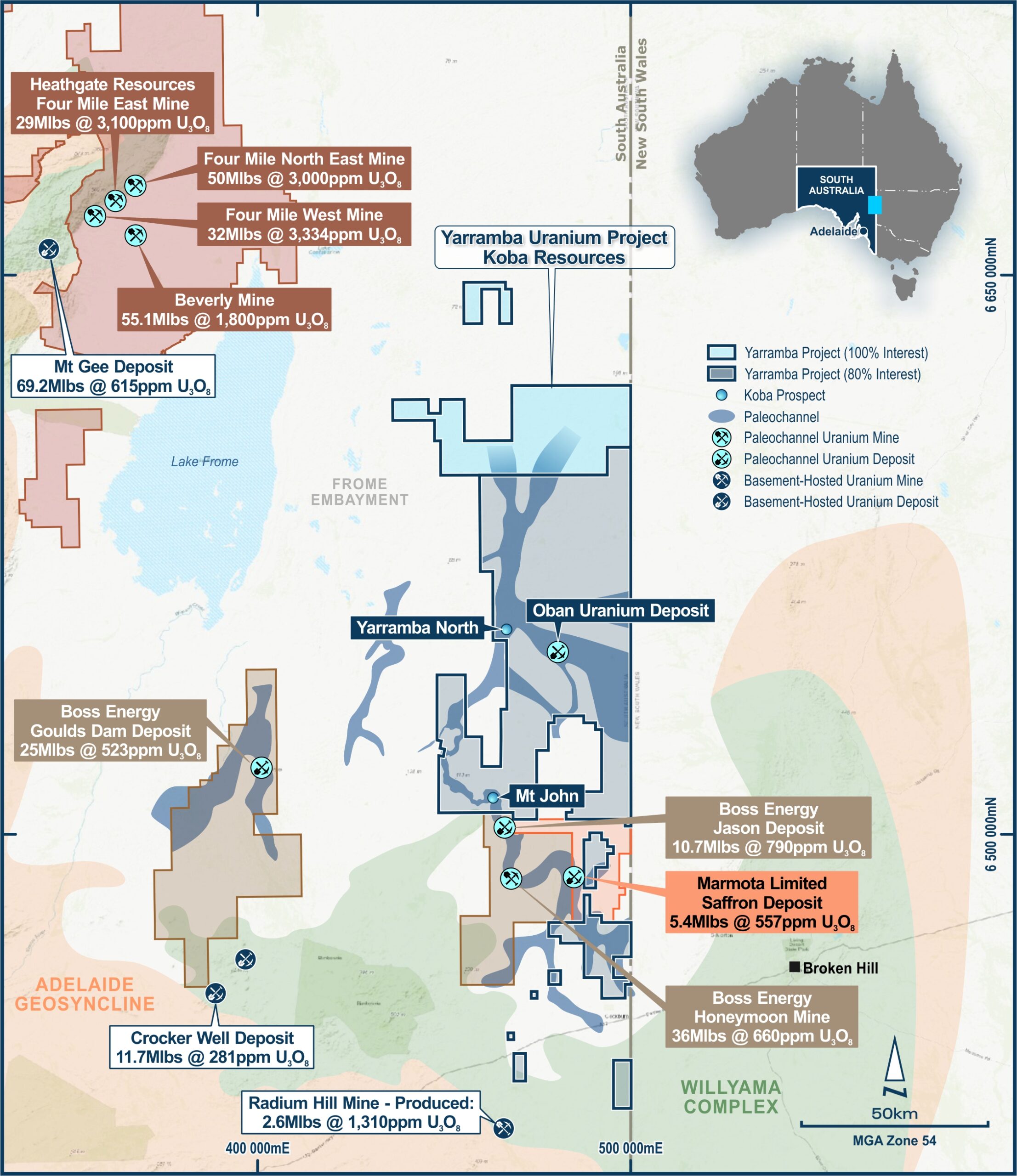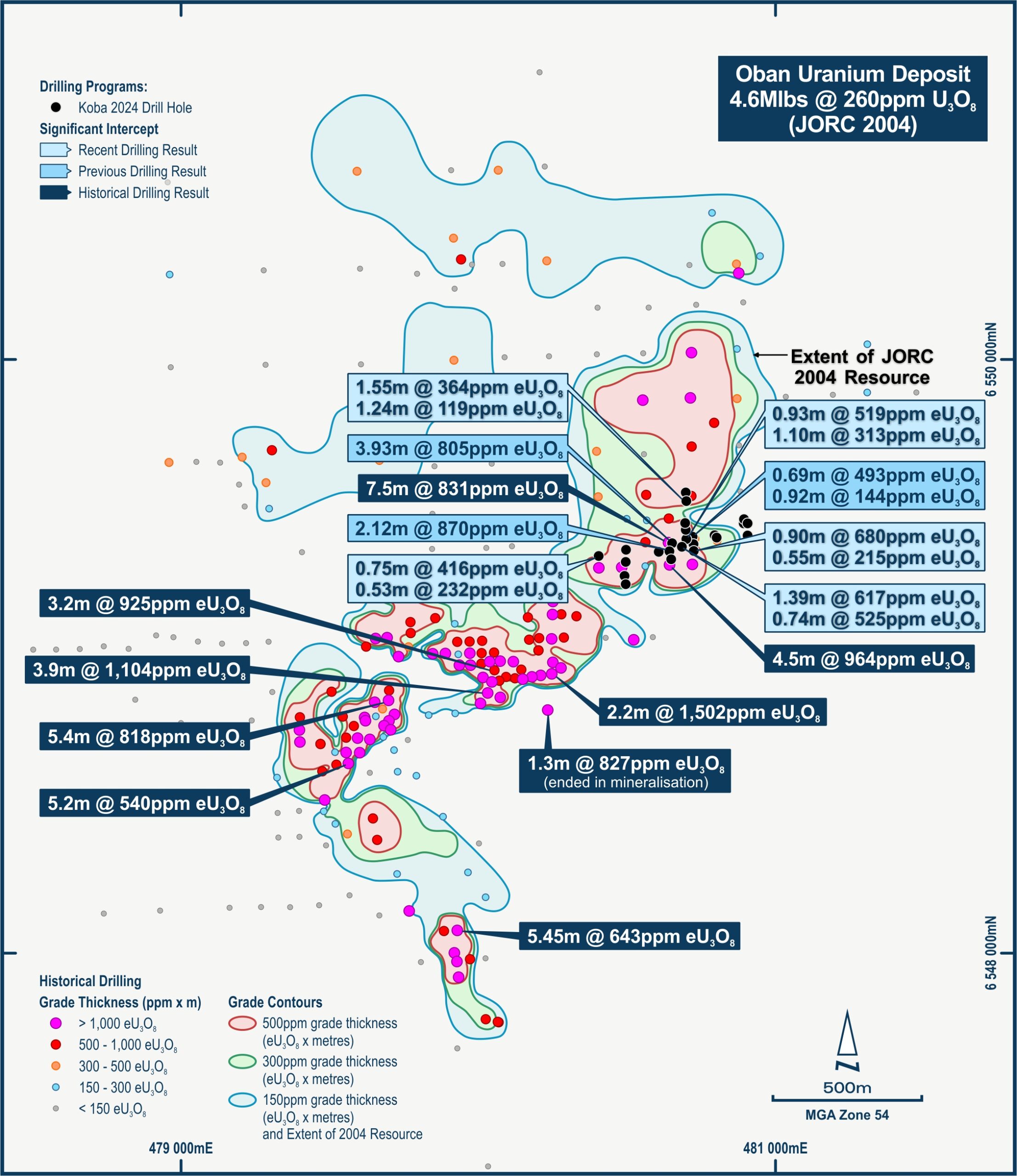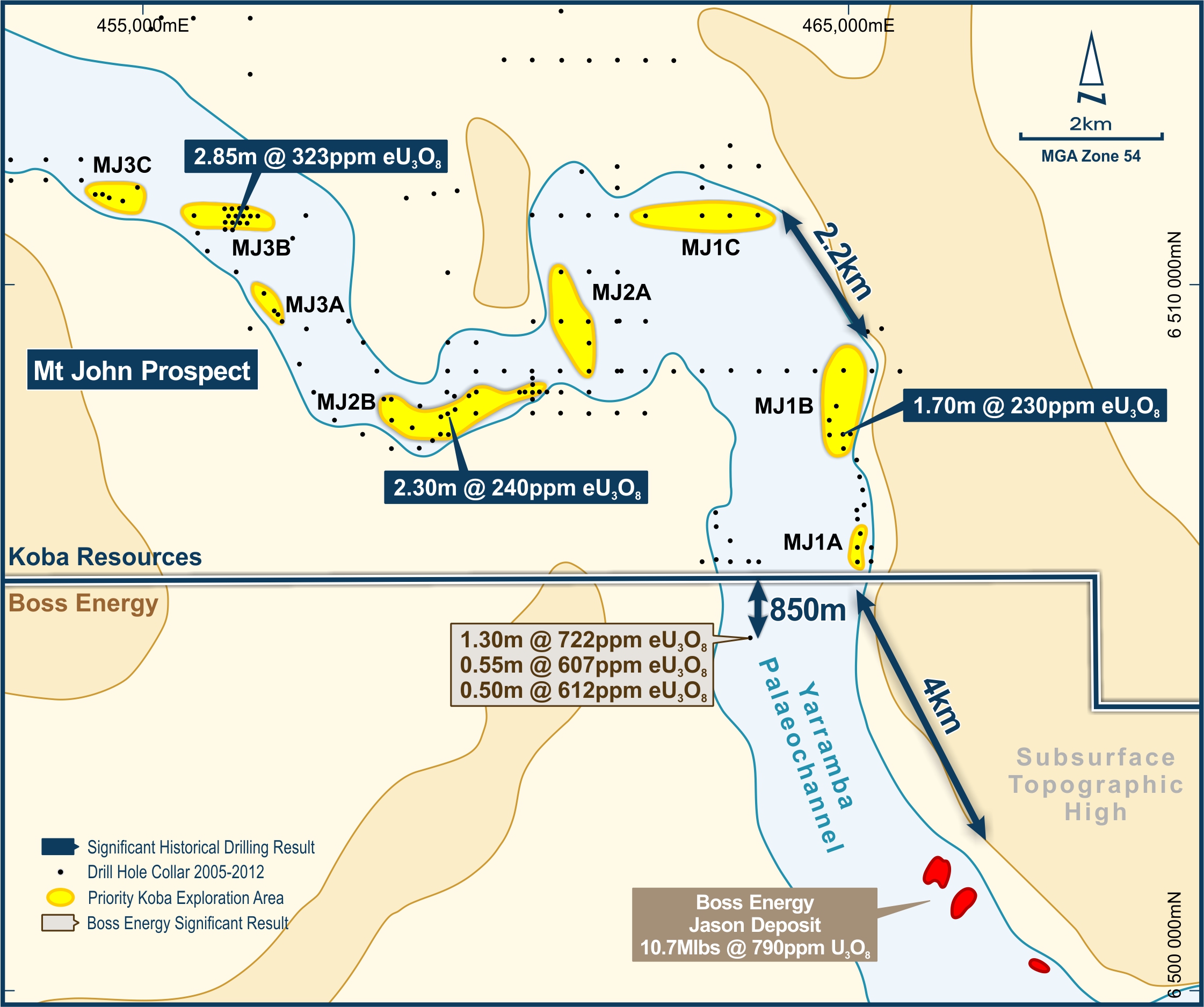The Yarramba Uranium Project is located in a world-class uranium district:
- 17km north of the Honeymoon Uranium Operation – where production recently commenced and resources total 71.6Mlbs of U3O8 at 620ppm U3O81; and
- 120km southeast of the Beverley Uranium Operation – with production of >40Mlbs of U3O8 during 20 years of continuous operation and where defined resources comprise 165Mlbs @ 2,766ppm U3O82.
The Yarramba Project includes the advanced Oban Uranium Deposit with a JORC 2004 Resource Estimate of:
- 8.2Mt @ 260ppm U3O8 for 4.6Mlbs of U3O83;
There are opportunities to discover extensions of thick, high-grade mineralisation at the Oban Deposit with previous drill intersections including:
- 7.5m @ 831ppm U3O8;
- 4.5m @ 964ppm U3O8; and
- 3.9m @ 1,104ppm U3O8.
The Yarramba Project includes an extensive pipeline of under-explored prospects throughout 250km of prospective paleochannels, providing considerable opportunities to make sizeable discoveries of high-grade mineralisation. Previous drill intersections include:
- 2.85m @ 323ppm U3O8 at the Mt John Prospect;
- 2.0m @ 530ppm U3O8 at the Yarramba North Prospect; and
- 1.0m @ 860ppm U3O8 and
0.5m @ 1,200ppm U3O8 at the Berber Prospect.
1 ASX:BOE – Boss Energy Annual Report 2023
2 https://www.world-nuclear.org/information-library/country-profiles/countries-a-f/appendices/australia-s-uranium-mines.aspx
3ASX:CUY – ASX Release 4 June 2009 – 2,100 Tonne Inferred Uranium Resource at Oban.
Oban Uranium Deposit
The Oban Uranium Deposit is the most advanced prospect within the Yarramba Project. The mineralisation at Oban is hosted within flat-lying carbonaceous and pyritic sands of the Eyre Formation at depths between 80 and 90m.
In 2009 Curnamona Energy Limited (“Curnamona”) announced an Inferred JORC 2004 Resource Estimate for the Oban Deposit. Only data from the 385 holes (37,918m) drilled by Curnamona were utilised. The resource estimate comprised:
- 8.2 Mt @ 260ppm U3O8 for 4.6Mlbs of U3O8*
*Applying a grade thickness cutoff of 0.015 metre-% U3O8 (150 metre-ppm U3O8)
The considerable potential to discover additional high-grade and thick mineralisation at the Oban Deposit is demonstrated by the significant results from previous drilling, which included:
- 7.5m @ 831ppm U3O8;
- 5.4m @ 818ppm U3O8;
- 4.5m @ 964ppm U3O8;
- 3.9m @ 1,104ppm U3O8;
- 5.45m @ 643ppm U3O8;
- 2.7m @ 1,174ppm U3O8; and
- 3.2m @ 925ppm U3O8.
The potential to expand the resource in the immediate vicinity of the Oban Deposit is further demonstrated by the intersection of significant mineralisation in monitoring wells outside the known resource area, subsequent to publishing of the resource estimate. Significant intersections from these monitoring wells include:
- 1.75m @ 626ppm U3O8; and
- 1.3m @ 830ppm U3O8 (with this hole ending in mineralisation).
The Oban Deposit is located in the central part of a poorly explored 7km long mineralised trend that extends approximately 4km northwest and 3km southeast of the Oban Deposit to the Berber Prospect and beyond. This mineralised trend provides the opportunity for further discoveries distal to the Oban Deposit. Multiple significant intersections of uranium mineralisation have been returned from broadly spaced drilling within this trend, including:
- 1.0m @ 860ppm U3O8; and
- 0.5m @ 1,200ppm U3O8.
30m-thick sand units have been intersected in drilling along this trend – which demonstrates it is a sizeable paleochannel, hence it provides an exceptional opportunity for the discovery of thick, high-grade uranium mineralisation.
In addition to growing the current resource, further drilling will also support the upgrade of the JORC 2004 Resource Estimate to JORC 2012 standards.
Mt John Prospect
The Mt John Prospect is located 17km north of the Honeymoon Deposit (36Mlbs @ 660ppm U3O8) and just 4km north of the Jason Deposit (10.7Mlbs @ 790ppm U3O8) – one of Boss Energy’s satellite deposits that may be developed as part of its Honeymoon operations (see Figure 4). Notably, Marmota Limited’s Saffron Deposit (5.4Mlbs @ 557ppm U3O8) is located 17km further east of the Honeymoon Deposit. All these deposits are located within the same Yarramba paleochannel that hosts the mineralisation at Koba’s Mt John Prospect.
Between 2005 and 2011 Curnamona completed broad-spaced drilling, to both define the extents of the paleochannel and as a first-pass test for uranium mineralisation. Drilling intersected widespread mineralisation, with results including (see Figure 3):
- 2.85m @ 323ppm U3O8; and
- 2.3m @ 240ppm U3O8.
Curnamona defined 8 priority targets within a 15km stretch of the paleochannel at Mt John (see Figure 3), where anomalous uranium mineralisation has been intersected in broadly spaced drill holes. Only limited follow-up drilling was undertaken, so there is potential to discover additional mineralisation with closer-spaced and extensional drilling.
Large areas of the paleochannel at Mt John remain completely undrilled – providing additional opportunities for new discoveries.
Mt John is a high-priority target area that warrants substantial additional exploration.
Yarramba North Prospect
The Yarramba North Prospect is located approximately 15km west of the Oban Deposit and 50km north of the Mt John Prospect within a continuation of the same Yarramba paleochannel that hosts the mineralisation at the Mt John Prospect and the Honeymoon and Jason Deposits (see Figure 4).
Mineralisation was discovered at the Yarramba North Prospect in 2008 when approximately 50 holes were drilled on 200m x 400m spacing across the interpreted location of the Yarramba paleochannel. Mineralisation was intersected in multiple holes within a zone of thick paleochannel sands, with results including 2m @ 530ppm U3O8.
Follow up drilling was undertaken with single holes drilled 100m east, south and north of that intercept. The hole to the east had a peak assay in excess of 100ppm U3O8, but no further follow-up work was completed. Closer-spaced drilling is warranted.
The Yarramba North Prospect is a high priority target area with considerable potential for discovery. Additional exploration will be undertaken in the near term.
Additional Target Areas Warranting Further Exploration
Prospective paleochannels extend for more than 250km within the Yarramba Project. Limited exploration has been undertaken outside the three main target areas described above. So there is considerable potential to make additional discoveries.
Additional early-stage target areas are shown on Figure 4 and include:
- Bingelly – Located 32km northwest of the Oban Deposit. This target was originally identified in 1974 when a single hole returned gamma readings 18 times background. Follow-up drilling in 2009 intersected 1m @ 225ppm U3O8;
- Yalkalpo – Located 26km northwest of the Oban Deposit; gamma readings up to 12.5 times background have been returned from four holes 2-3 km apart. Limited drilling in 2009 returned an intersection of 1.35m @ 184ppm U3O8;
- Bingelly North – Located 38km northwest of the Oban Deposit. A single hole in 1974 returned gamma readings up to 20 times background at 24-28m depth and 6 times background at 95m depth. These results were duplicated in 1979, but no follow-up has been undertaken subsequently.
- Oban North – Located 4km northwest of the Oban Deposit where drilling returned gamma readings 10 times background at depths of 20-40m.
- Jacks Reward – Located 24km northwest of the Oban Deposit; a single drillhole in 1974 returned gamma readings up to 8 times background. Curnamona drilled a traverse of reconnaissance holes 1.5km to the south and recorded similar gamma responses. No follow-up drilling has been undertaken.
- Kidman Bore – Located 30km north-northeast of the Oban Deposit. Downhole gamma readings 10 times background were returned from 40m depth in 1971 and confirmed in 1981 when 3 holes returned very strong gamma responses. No follow-up has been undertaken subsequently.
Geology and Mineralisation
The Yarramba Project lies within the Frome Embayment – a sedimentary basin that hosts multiple sand-hosted uranium deposits. The majority of these occur within Cenozoic paleochannels, which overlie the sediments of the Cretaceous Eromanga Basin, which in turn overlie Proterozoic basement rocks (see Figure 5). These basement rocks are naturally enriched in uranium and, in some instances, host primary uranium deposits, including the Mt Gee Deposit (69.2Mlbs @ 615ppm U3O8), Radium Hill (past production of 2.6Mlbs @ 1,310ppm U3O8) and the Crocker Well Deposit (11.7Mlbs @ 281ppm U3O8) (see Figure 1).
Tabular and roll-front uranium deposits formed within the Cenozoic sediments along contacts with clay horizons and along paleochannel margins. Groundwater, enriched in uranium dissolved from the Proterozoic basement rocks, passed through the sands until it was precipitated when it encountered organic material (or other reductants).
Approximately 18% of the world’s commercial uranium deposits are sand-hosted uranium deposits (like these). In addition to the South Australian deposits, there are also sizeable sand-hosted uranium deposits in Kazakhstan and the USA.
Figure 5. A cross-section showing the stratigraphy of the Frome Embayment area and the position of various uranium deposits within that stratigraphy.
Regional Exploration History
Uranium deposits were initially discovered in the Frome Embayment in the late 1960s and early 1970s.
The Beverley Uranium Deposit was the first major discovery – in 1969. Heathgate Resources Pty Ltd acquired the project in 1990, and, in 1999, commenced ISR operations. Total resources of 165Mlbs of U3O8 @ 2,766ppm U3O8 have been delineated. The Beverley mine has operated continuously for more than 20 years, with total production of more than 40Mlbs of U3O8. Further discoveries at Four Mile and Beverley North were subsequently incorporated into the Beverley operation.
The Honeymoon Uranium Deposit was discovered in 1972. Work at Honeymoon included the construction of a test plant in 1980. Additional uranium was subsequently discovered, to the west, at Goulds Dam. Southern Cross Resources Inc (subsequently SXR Uranium One Inc) amalgamated the Goulds Dam and Honeymoon Projects and between 2011 and 2013 produced 200,000lbs of U3O8.
Boss Energy Limited purchased the Honeymoon Project in 2015. It recommenced operations in October 2023. Total resources at the Honeymoon Project comprise 71.6Mlbs of U3O8 @ 620ppm U3O8.
Yarramba Project – Exploration History
Significant uranium mineralisation within the Yarramba Project area was first discovered during exploration in the mid-1970s, north of the Oban Deposit.
The Oban Deposit was subsequently discovered in 1981. It was acquired by Paladin Energy Limited in 1998, and 117 holes were drilled (12,131m) in the greater Oban area. Havilah acquired the Oban Deposit and surrounding tenements in 2004. Havilah demerged its uranium portfolio into Curnamona via an IPO in April 2005. Havilah retained a circa 50% interest in Curnamona.
Between 2005 and 2012 Curnamona drilled 1,074 holes for 104,335m within what is now Koba’s Yarramba Project. Curnamona’s primary focus was the Oban Deposit, but initial exploration work was also undertaken to follow-up on discoveries of isolated uranium mineralisation at the Mt John Prospect as well as at other prospects.
In April 2012 Havilah initiated a takeover of Curnamona and acquired all the remaining shares. No exploration (for uranium) has been undertaken in the area since 2012.
Between 2006 and 2012 Areva Resources Australia Pty Ltd. completed broad-spaced reconnaissance drilling north of the Oban Deposit, including 244 holes for 25,715m. Havilah subsequently acquired Areva’s tenements. This area is included in Koba’s Yarramba Project.







